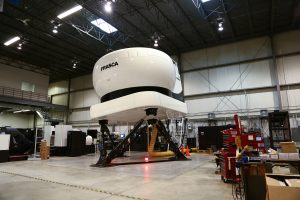
How Much Does a Frasca Flight Simulator Cost?
This is a great question and one we get more than any other. The quick answer is that price depends on several factors; training needs, the aircraft type, the level of the device qualification (FAA, JAA or equivalent), device features and more. Due to the wide range of flight simulation products available, the cost can range from several thousand dollars to several million. To get a more accurate answer, let’s dig a little deeper by breaking this down to product levels.
Entry Level: Reconfigurable Training Device (RTD)
Our entry level simulator, the RTD, represents basic systems and general aviation aircraft. This Advanced Aviation Training Device (AATD) is ideal for small single-engine aircraft flight training and recurrency training. The device features a simple open cockpit, highly standardized instrument panel and flight controls and the ability to be reconfigured to represent multiple aircraft. Because of product standardization, the RTD can be manufactured in larger numbers, keeping costs down. Pricing starts at $50,000 for a single aircraft model with steam gauge configuration and a single channel visual system. We offer several options to further customize the device to your specific needs – multiple aircraft, Garmin G1000 NXi glass cockpit, and multiple visual channels – which can increase the cost to $120,000 or more.
The Most Advanced: Full Flight Simulators (FFS)
At the opposite end of the spectrum are the highly customized FAA Level B-D Full Flight Simulators (FFS), which typically cost between $5 and $15 million. What drives simulator cost for the FSS is the ability to highly customize the design per customer’s specific needs. Heavily regulated by the FAA and EASA, they include six-axis motion systems, control loading systems, advanced visual systems, instructor stations, exact cockpit replicas, and a sophisticated aircraft data package. While most of these features are common with lower Level FTDs in the case of the FFS, they must meet the exacting requirements of regulating authorities, including initial approval and quarterly tests to maintain the approval. These approvals are handled by Frasca and are included in the price. In addition, all Frasca FFS devices include licensing intellectual property and data packages from parties involved in the aircrafts design and manufacture – a significant investment covered by FRASCA. Potential items factoring into the cost for a Full Flight Simulator can also include real aircraft parts from the OEM and actual avionics from the OEM.
In the Middle: AATDs and FTDs
While there is a wide price range between FRASCA’s lowest (RTD) and highest (FFS) priced simulators, Frasca offers a large selection of mid-level devices between the two to fit your training requirements and budget. These include AATDs and Flight Training Devices (FTDs) for both fixed wing and rotary wing aircraft.
Many fixed wing and helicopter Flight Training Devices (FTDs) are built to print (BTP). These units represent specific aircraft and are typically configured for FAA AATD, FTD 5, and FTD 6 approval as well as EASA FTD 2 and FNPT 2 approval. FRASCA’s BTP FTDs are built from existing designs which means that we are able to amortize development costs over a large quantity of units.
Available for Cessna, Piper, Diamond, Cirrus and other popular fixed wing aircraft, our BTP FTDs include many standard features with many options available such as choice of avionics packages and visual systems. The simulator cost of a fixed wing FTD is largely dependent on a customer’s configuration and options chosen. FRASCA’s BTP FTDs start at around $200,000 for a piston aircraft and $700,000 for a turboprop or jet aircraft.
FRASCA has recently introduced standardized general aviation devices with lower pricing for several aircraft types including; Cessna 172, Piper Seminole, Piper Archer, Diamond DA40 and DA42. We decided to develop this new approach because we saw and understood the potential difficulties and challenges that the COVID pandemic has brought to many in our flight training community. In order to help ease the difficulties and complexities COVID has created, Frasca took deliberate measures to re-visit our designs and find ways to gain efficiency without losing quality. Our goal was to find ways to reduce our costs and be able to pass along those savings to customers in the form of lower prices for the same great devices. While these new standard options are currently available for select aircraft platforms, we do intend to develop more as time is available to us. In addition, customers can still add customization, such as specialized equipment, avionics or training needs. Prices for this new standard device offering start in the low $200,000.
FRASCA’s helicopter FTDs represent a variety of rotary wing aircraft from Airbus, Bell, Robinson, Leonardo and others. Helicopter FTDs have even more options available than fixed-wing due to the complexity of the aircraft. Cockpits and visual systems can include NVG stimulation and complex display systems with up to 10 channels. Additionally, specialized mission simulation for EMS, law enforcement, firefighting and military with specialized equipment and databases is available. Due to increased complexity and lower production efficiencies, helicopter FTDs are generally more expensive than fixed wing devices. Helicopter FTDs start around $350,000 and can go up to $4,000,000 for a very complex, turbine-engine aircraft device with advanced features and mission scenarios.
In conclusion, there are many factors that drive simulator cost. FRASCA’s pricing is based on aircraft type, device features and qualification level for our specific product line. Other simulator manufacturers have different product lines and pricing. Substantial price differences between manufacturers may be due to major differences in fidelity, features and qualification levels. It is also important to consider customer service, installation, training and warranty when comparing price.
Feel free to contact a FRASCA representative to discuss simulator pricing, features and return on investment with respect to your needs and budget. We’re happy to answer all of your questions.






